|
I recently unearthed an old exercise book, dating back to 1935 when I was 15 and still a pupil at Ducie Avenue Central school in Manchester. Re-reading an essay on "A Library of my own" is revealing... Right at the start, I mention that the type of literature I find appealing is "scientific fiction... often abbreviated to 'scientifiction' or 'science-fiction'", then struggle clumsily to define it: "stories which do not happen in reality, so being fictitious, and possessing scientific relations".
I hastily added the qualifier that: "not all stories having these two features, however, are science-fiction. Only by reading this type of fiction can one recognise genuine science-fiction", and supplied a few familiar author's names such as Wells, Verne, Burroughs, and others "less familiar in England but well known in America", such as Eando Binder, Laurence Manning, A. Hyatt Verrill and Dr. David H. Keller, who feature in the pages of the magazines Wonder Stories and Amazing Stories.
I describe the thrill of picking up several Wells volumes reduced from 3/6d to one shilling each in a book sale the previous Christmas, of buying cheap editions of The Invisible Man, The Island of Dr. Moreau, and The Sleeper Awakes from Woolworths, of searching secondhand book shops for Burroughs' Martian books, I mention visits to the barrows in the city centre market for remaindered copies of Wonder Stories and Amazing Stories, and occasional Annuals, all of which, in later years, formed the nucleus of the SFA Manchester Branch library.
Surprisingly, perhaps, many of the volumes acquired in those far-off days still survive on my bookshelves. The magazines are long gone, cleared out when I gafiated from fandom in the late 1950s (though a few were salvaged by son no. 1, who inherits my own hoarding instincts). ■
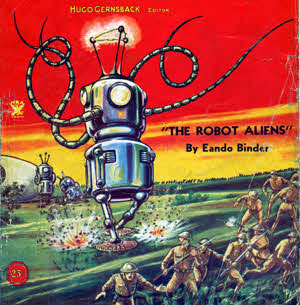
above: original magazine cover of Wonder Stories Vol. 6, No. 9 (February 1936) with artwork by Frank R. Paul
right : copy by Harry Turner for his own bound version of the magazine | 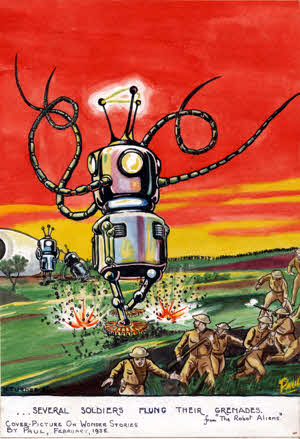 | |
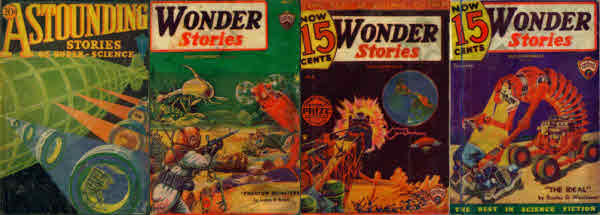
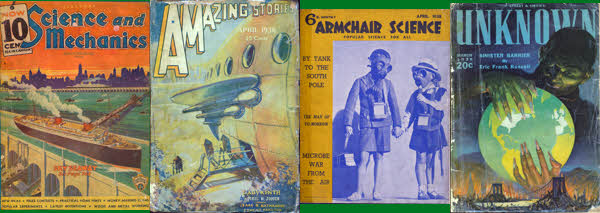
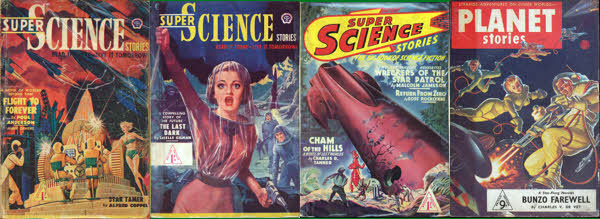
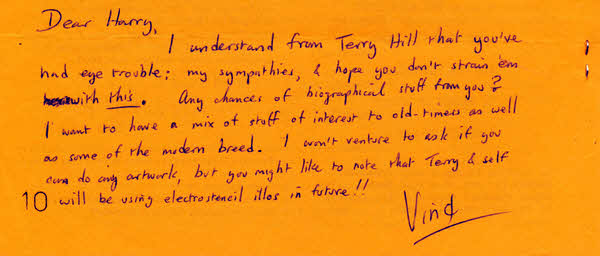
Note from Vin¢ Clarke on back page of Not SCIENCE FANTASY NEWS for June 1982.
Response to a request for artwork from Steve Green of Critical Wave for a portfolio, July/August 1993
Can this be a leg-pull ? I ask myself. It's true that I've another birthday due this coming weekend, which means that it's now 56 years since I did my first fanzine cover.
I'll assume your proposal is serious though the thought of putting a 'representative selection' into four pages... wow. No problems about sending samples of recent work for you to mull over. Going further hack is not so much a matter of selecting as making do with whatever comes to hand.
You may be disillusioned to hear that I do not have a vast archive of work turned out over the years. For a start, all the early work of the 30s, 40s was drawn direct on to stencil; there was no original artwork. So, all the material is buried in the mouldering fanzines such as have survived the years. Practically all I had passed out of my hands years ago. Fortunately, the Heritage Fanzine Library, run by A. Vincent Clarke, has turned up some items for me. I present you with a few cleaned up prints.
Again, I did a fair amount of illustration for sf mags—mainly Science-Fantasy and Nebula SF—during the 50s. Publishers/editors rarely bothered to return artwork after use in those days, and the standard of reproduction in the mags doesn't give adequate photocopies. All I can lay hands on at present are some items that had to be redone owing to editorial rewriting of a story (after I'd done the illustrations, natch) and some rare returns.
My hopes of earning a living as a freelance artist crumbled in the 60s in the face of impecunious sf publishers inability to pay a decent rate! As for later fanzine work, I've tried to pick a few items that will survive the somewhat drastic reduction they may face to fit on your four pages. Look them over, and let me know if they meet your expectations.
Fandom first saw my artwork on the covers of Novae Terrae, monthly bulletin of the newly-formed Science Fiction Association, way back in 1937. Fifty plus years later, to my surprise, I still can't resist responding to pleas for artwork from fanzine editors.
My taste for sf was sparked in the late 20s, during visits to an uncle in whose library I discovered bound volumes of turn-of-the-century magazines like the Strand and Pearson's. I revelled in tales and serials by H.G. Wells, George Griffith, Conan Doyle, Cutcliffe Hyne and countless others; and the illustrations of invading Martians, prehistoric monsters and alien landscapes set me off drawing my own feeble versions. Then I became an avid reader of American sf pulp mags, haunting Manchester's city centre market in search of remaindered copies of Amazing, Wonder and Astounding Stories, wide open to the influence the illustrators: the ubiquitous Frank R. Paul, Wesso and Elliot Dold.
In the art class at school I was largely left to my own devices, happily churning out fantastic drawings and paintings that dominated the displays of work on the artroom walls. When later I became involved in the first active stirrings of British sf fandom and found fanmag editors looking for artwork, I was only too happy to help out.
The fanmags of the 30s and 40s were shoestring productions, usually cranked out on decrepit duplicators. I made myself some styluses, found a few wheelpens, and practiced drawing direct on to wax stencils, acquiring a certain facility in this limited artistic medium.
Right through into the early years of the war, I was kept busy providing cover designs for fanmags like Novae Terrae, Fantast, Satellite, New Worlds, Futurian War Digest, and eventually published my own mag, Zenith. This burst of feverish activity ended When I was drafted into the RAF.
The outbreak of war also put a stop to dreams of earning my keep as a freelance illustrator. Back at the 1938 London fan convention I'd met Wally Gillings, editor of the new, struggling, British pro-mag, Tales of Wonder. Despite resistance from a cost-cutting publisher, Wally introduced small illustrations into the pages of the magazine, and I started to draw for him. When a rival mag, Fantasy, appeared I was asked to do work for that too. But it proved a very brief career!
This ambition revived in the 50s, when I spent several years illustrating British sf magazines, mainly Science-Fantasy and Nebula SF. But with a growing family and a newly-acquired mortgage to support, I had to face the hard reality that the financial rewards of freelance were slight, and editors' tastes decidedly conservative. I settled for running a design studio for a regular income.
I still did graphics for editors of amateur magazines—their increasing use of litho printing offered my work more scope and better reproduction. But most of my spare time was devoted to painting and I showed work regularly with local art societies and in open exhibitions.
I became intrigued with perceptual anomalies and the wide diversity of 3-D illusions in flat geometrical patterns. Exploration of the inherent visual deficiencies of isometric drawing led me to a system for creating 'impossible figures', which in turn can be used to generate infinite paradoxical patterns, reminiscent of Islamic geometrical art.
I reckon I could cheerfully spend the next 50 years sorting out the ramifications of this development... ■
A couple of things for you . . .
2. Photocopies of hand-drawn illustrations from a duplicated fanzine. They are from ZENITH Number Four, February 1942, published and illustrated by Harry Turner. Harry was "whisked away into the RAF" in the middle of the sixth issue and only one further issue was produced, a photolithoed magazine dated June 1953 when Harry and I were joint editors. There were several full-page drawings such as these as well as the front and back covers in each issue. For my money Harry is the finest freehand artist EVER to work on ink duplicating stencils.
LoC from Derek Pickles to Thomas Sadler's The Reluctant Famulus (September 1992)
. . . I've always said you were the best artist in fandom on either side of the Atlantic from the earliest mimeo era. I still have a few VoMs with some of your stuff. I still marvel at and wonder how you persuaded that most difficult medium, the mimeo stencil, to give up even decent repro, let alone excellent.
If you no longer do fan art (like Alan Hunter) I'd like to reprint some of your illos from VoM. I doubt 4e will mind if you don't. I saw some of your work in The Reluctant Famulus, but suspect it may have been plucked from some ancient fanzine rather than current.
If you will part with some current work(s), I'd be honored to feature it (them) in future YHOSIM. It has a French pronunciation (E-HOCE) and a Hebrew plural.
Thumbs Up, Art.
note by Art Widner on back page of Yhos #53 (October 1993)
NEXT ISSUE
We will span 53 years of fan art with Harry Turner's elegant Escher-ish cover, representative of the work he is doing now. The pic on p. 31 [below] is my nomination for the best mimeo stencil art of all time. It appeared in 4e Ackerman's Voice of the Imagination #23, June 1942.
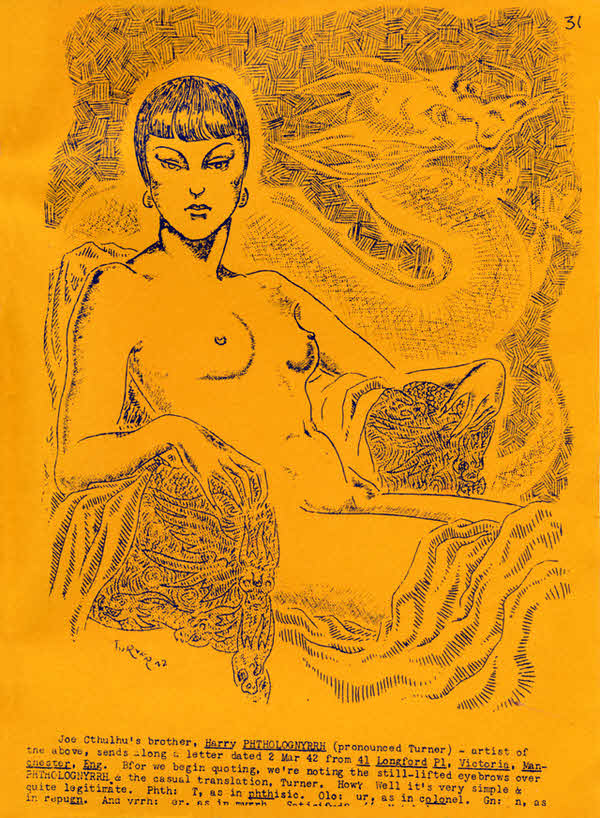 [Note: Students of SF art are invited to locate the 4E logo concealed in the picture.]
[Note: Students of SF art are invited to locate the 4E logo concealed in the picture.]
comment from page 30 of Art Widner's Yhos #54 (November 1995), artwork on inside back cover
Front cover of Yhos 55 by Harry Turner
with lettering in his "ISO-Paradox" typeface

FOOTNOTES TO FANDOM #6...
one of a series of occasional pieces published by the Septuagenarian Fans Association
| 


